 |
Fred
Brack Raleigh, NC |
|
 |
Fred
Brack Raleigh, NC |
|

![]()

This page documents my experience ordering GigaPower fiber Internet service, combined with home phone and DirecTV in the summer of 2016. The location is North Raleigh, NC, and your experience anywhere else but my neighborhood may be completely different! I am documenting this here primarily for my neighbors in Traemoor Manor.
NOTE: AT&T is reportedly phasing out the name "U-verse" by May 30, 2017, so the service names below may change.
 December 2019: While I still have my AT&T "GigaPower" Internet service, I
recently "cut the cable" for phone and TV. I replaced my phone service
with Ooma, and I replaced my DirecTV service with an
Amazon Fire Recast DVR. You can read about how I researched
solutions and came to choose the Recast at the following page, if interested:
Cord-Cutting Options Supporting
Audio Description. While my choice was oriented toward a service which
met my family's needs in supporting audio description, you can also learn other
options on that page in addition to reading detailed information about the
Recast DVR.
December 2019: While I still have my AT&T "GigaPower" Internet service, I
recently "cut the cable" for phone and TV. I replaced my phone service
with Ooma, and I replaced my DirecTV service with an
Amazon Fire Recast DVR. You can read about how I researched
solutions and came to choose the Recast at the following page, if interested:
Cord-Cutting Options Supporting
Audio Description. While my choice was oriented toward a service which
met my family's needs in supporting audio description, you can also learn other
options on that page in addition to reading detailed information about the
Recast DVR.
Based on a door-to-door solicitation on June 4th, 2017 (remember that date...) from a very nice young lady, I ordered a "package" consisting of
The package price was to be $155 per month plus tax with the introductory price good for two years (no installation charge, but a $20 "handling fee"). This was a savings of about $45 from my existing Time Warner (now Spectrum) Cable TV and Internet service plus my regular AT&T home phone and a separate long distance service. In retrospect (see below) I shouldn't have ordered the "Ultimate" TV package, and I subsequently downgraded to the Preferred XTRA plan; but that's just me...
10 days later a technician arrived. I assumed he was there to install everything, but he only handled DirecTV. The installation went smoothly, and he setup my "master" DVR for the family room TV and 3 "mini" receivers for little-used TVs elsewhere. (The introductory package price included up to 4 TVs.) Bottom line: DirecTV works fine; and other than changing packages (which saved me about $15/month), I've had no problems (though I do miss the digital clock that was on my TWC DVR...).
Technical information:
Skip this section if the technical details don't interest you, but observe the warning at the end not to place the Gateway inside a metal box, or its signal will be blocked!
Service comes from AT&T "Platforms" located throughout the neighborhood, each serving a subset of neighborhood homes. They are light green boxes about 2 feet tall by 8" square. An underground flexible conduit connects the Platform to Hand Holes (medium green covers flat on the ground) throughout the neighborhood, and Hand Holes are often located on opposite sides of the street, connected with conduits under the roadway to service individual properties. The idea is that when someone orders service, a technician connects a roll of optical cable (fiber) to a "pull tape" left in the conduit to pull it from Platform to Hand Hole to Hand Hole to reach the customer's property. From there, the actual cable is buried on the property to get from the street Hand Hole to the entry point on the home.
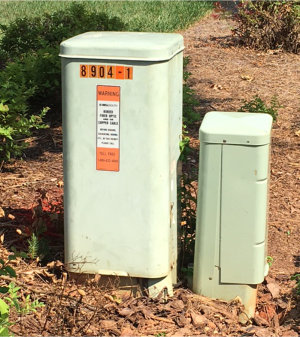
AT&T Platform: Conventional Phone Service on Left,
and GigaPower fiber service on Right
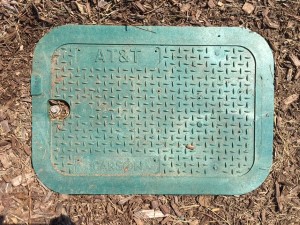
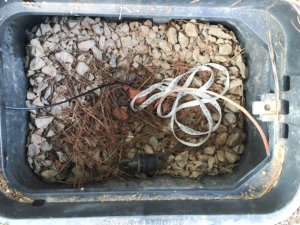
Left: Hand Hole Cover; Right: Inside the Hand Hole
Inside, note orange conduit crossing street, black fiber line to customer
property, white pull tape.
The orange "wire" is a tracer for locating the conduit underground.
If there is a nice clean open run from the Hand Hole to the house, a machine can be used to bury the cable. If it is more complicated, such as needing to go along the edge of a driveway or though a treed area, the cable will be hand buried A FEW INCHES deep. If the cable is later severed, it will not be patched: the cable will need to be replaced all the way from the Platform. Net: BE CAREFUL to note exactly where the cable runs, and don't dig there in the future, and don't let a contractor dig there! (My neighbor's was severed by a contractor.) They are only allowed to leave a cable running on the surface if it is in a covered area such as under a porch.
The cable can be PRE-BURIED or POST-BURIED. By that I mean an installer may pull and run the cable both underground (Platform to Hand Hole) and above ground (Hand Hole to your house), putting in an order for another crew to return to finish burying the cable later, OR you (or an installer) can call for a PRE-BURY, where a crew runs the cable underground the entire way, and the installer just attaches it to the Interface on your house.
Once at your house, the installer mounts a fairly large plastic box (Optical Network Terminal, or ONT) outside which houses the electronics which convert the optical signal to a digital one. A line runs from there to someplace inside where your "modem" (called a Gateway by AT&T) is to be installed. In addition to the Gateway (mine is a Pace 5268AC), you need a substantially sized Power Supply. Both the Gateway (nearly 11"x7"x2-1/2") and Power Supply seem much larger than necessary, though a provision for a backup battery (not supplied) takes up some of the space in each of them. The outside ONT requires power, so a second line must run from the Power Supply to outside. Technically, the Power Supply (at least the one installed for me) is called an Uninterruptible Power Supply (UPS), a Delta model DUPS-1232A. Without the optional battery (model GT12080-HG, about $20), of course, service is totally interruptible during a power failure, and you will have no phone or internet! For your phone service and internet to be truly protected, though, you would also need a battery in the Gateway (Pace Battery, $40); but a better idea might be to purchase your own uninterruptible power supply (UPS) and plug in both the Gateway and Power Supply (this $50 one would probably do fine).
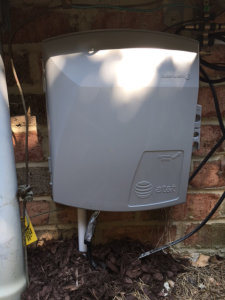
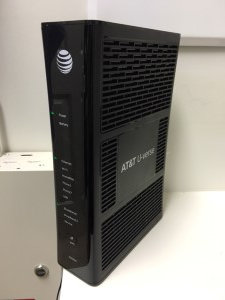
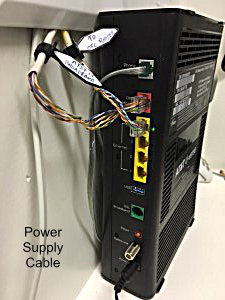
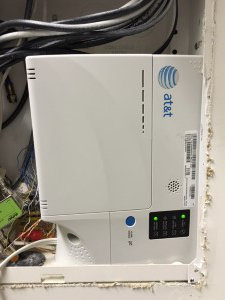
Optical Network Terminal (outside), AT&T Gateway (front and rear),
and Power Supply
The Gateway and Power Supply both require 110VAC wall power
Gateway connectors are Phone out (top); Broadband In (from Interface outside);
and (in my case) output to my own Router; power in at bottom
Now the way this all works is that the Gateway provides THREE types of outputs:
SO ... you need to get the Gateway Telephone jack connected to your own household telephone outlets. I suppose you could simply run a "telephone cable" from the router to any existing wall port to do the distribution, but you'll work that out with your installer. And you can either use the provided AT&T wireless router, your own router (by connecting to an Ethernet port like I did, or pick up the signal wirelessly for retransmission if you know how). DO NOT place the Gateway inside a metal box! You will block the signal. Another alternative is to use a repeater to pick up the wireless signal and retransmit it throughout your house. You are unlikely to get much help on these options from your installer. NOTE: You can configure the AT&T router via an address on the back of the router. For me that is 192.168.1.254. You will also need the Device Access Code imprinted on the back of your router. The software interface in the Pace Gateway is impressive, one of the best I have seen.
Oh boy. My personal experience is probably highly unusual, but this COULD happen to you, so here it is...
First, AT&T lost my order for the Internet/Phone service, so no one showed up after the DirecTV installation. Ironically, I kept getting emails telling me they were sorry I canceled my order! I called my sales rep (get his or her phone number!) and she reentered it. My (first) install date was June 27 (remember THAT date, too). The installer came and worked for over two hours to run the line from the Platform to the Hand Hole across the street from my property. Eventually, when he got a specialize piece of equipment, the "pull tape" in the underground conduit broke, ending his efforts. He put in a call for a cable pre-bury to be scheduled.
I honestly don't remember when the first pre-bury crew showed up, but they couldn't pull a line either. A week or so later another crew came to do the job. They told me they were from Georgia, and they were much better. Ha! They couldn't pull the cable either. The third crew arrived and said, "you tried the rest, now you've got the best." Right. They worked four hours in blazing heat but couldn't force a line through. They concluded the conduit was jammed with something (possibly a dead animal or maybe just bunched up pull tape), so they put in a request to have the original conduit installers, Ansco, come to unclog the line. No one came -- just the same team AGAIN, who complained to their boss. Finally another crew came (not Ansco) and got some specialized equipment and finally unclogged the line. They ran the cable from the Platform to the first Hand Hole, then under the street to the second Hand Hole (on my property, but on the wrong side of the house). Then they hand dug a SHALLOW trench beside my driveway, through my fence into the back yard, across the yard to the edge of the deck, where they stopped, and left rolled up cable for the final installer, who came a week later.
So finally, on September 7, more than three months after my original order, the installer came and completed my installation. I told him it was fine to allow the cable to run above ground under the porch and deck, which covered most of the remaining distance; but installers don't bury cable, so the last 20 feet were left above ground near my foundation. I later buried this myself, right against the foundation. In retrospect, I wish I had pulled that cable in through a vent opening under the porch and run it myself along the ceiling of the crawl space to where it had to go.
I decided it would be best to install the Gateway near the box inside my house where all my phone wires were consolidated. Fortunately, there were two lines coming in from the old telephone connection (one of which was a spare); so the installer had his feed back from the internal power supply to the external interface that he needed. The resulting installation was a bit awkward, because the AT&T equipment was so large, but I made it fit (as seen in the photos above). Fortunately, I was quite familiar with all the wiring so I was able to advise the technician on options. I'm not thrilled about the awkwardness of the connections, but it will do.
Let's divide this into the three different services: DirecTV, U-Verse Phone, and GigaPower Internet.
Overall I'm happy with this service. You need to remember, though, that satellite services are subject to weather interruptions, unlike cable. I have had a few situations where recorded programs were damaged. Also, there are at LEAST six levels of service you can buy, from "Select" (the most basic service of 145+ channels) to Premier (315+ channels including HBO, Showtime, and more premium packages). At some point, a "Regional Sports Fee" ($1.95/month, I think) kicks in. Most of you will probably want lots of sports channels, but I didn't; so I downgraded my service from the Ultimate package to the Preferred XTRA plan for a $15/month savings at the cost of some lost channels that I really didn't care about. Once you choose a plan, you can go to the DirecTV.com website and print out a list of the exact channels you receive.
Please note: there are LOTS of options using the remote controller for DirecTV -- things like setting favorite channels or a quick way to record a series. STUDY THE MANUAL! (Make sure the installer leaves it.)
Sigh. There were some disappointments here: some features lost and an outage. But a few nice additions, too.
The phone signal is nice and clear. However, on the third day after installation, there was a loud hiss on the line and we could hardly hear the dial tone. The solution was to unplug the Gateway and let it reboot. Annoying. I'll post back here if this happens again.
The primary disappointment is the loss of a feature we used regularly on our previous AT&T "Community Caller Plus" service: Speed Dial. We had programmed the digits 2 through 9 to dial family and friends, and we would push, for example, 3# to complete the call to a number we never bothered to memorize. That's not the only feature they dropped, but it was the most important one to us. So I had to go out and buy a new set of phones ($100) with the ability to program the digits 1-9 to numbers you wish at the PHONE level, rather than the AT&T level. OK, we're lazy, but we got used to that feature!
They also changed the way to perform other tasks. For instance, to cancel Call Waiting for just the next call, we used to dial *70# before dialing the number. Now we dial #70, followed by the number, followed by #. It's just something different to get used to.
On the other hand, there is something good! CALL BLOCKING is handled differently. Before I was only able to block six numbers, and not every number was blockable. Now, by going to the AT&T website under myAT&T, Manage Features, I can enter up to 20 numbers to block, with no restrictions. That's also where you set up other options, including call forwarding (under various circumstances), exclusive call forwarding (where you always forward specific numbers either to VoiceMail or another number - interesting), and certain other options. There is also a page of extensive options for VoiceMail, which we have not setup yet, as we are currently content with our own in-house system, though we may switch to it because it can take VoiceMail while we are on the phone. (We later did that, and it works well.)
(Later, I discovered that by using the FREE service at www.nomorobo.com, I could block robocalls automatically. WORKS GREAT! That only works for VOIP services like this, not copper.)
Well, if you were thinking you were going to jump to 1 Gbps (1000 Mbps) download speed on your computer, think again! (Turns out I had several problems with the installation, since resolved, but the previous statement stands!) Initially, the download speeds were all over the place, averaging 160 Mbps, and I couldn't get more than 100 Mbps service to my modem. I called AT&T, and impressively they sent a GOOD technician (Jerry W) to my home the next day. He found multiple problems (including a prewired wall Ethernet outlet which was connected in "B" mode instead of "A" -- see Note below) and things have been much better since. The AT&T "promise" is to give you 600 Mbps minimum from the Ethernet ports. In reality, my direct Ethernet UPLOAD speed is in the 700s, but the DOWNLOAD speed is barely 600. There are many factors at work here, so getting top speed at your workstation may require some tweaking.
How you access the Internet (wirelessly through their modem, direct connection, or via your own direct-connected modem), along with your own computer's Network Interface Card's speed and your own router's max speed will affect your outcome. In my case, my computer's Ethernet card (for direct connection) handles 1 gigabit, a perfect match, while my Wireless card handles 867 Mbps (which I would be thrilled to receive!). My router handles 1.3 gigabits, so that's fine also. For a number of reasons, I prefer to run wirelessly off my own router and ignore the AT&T Gateway router completely. Currently my numbers are around 550 Mbps down and 450 up -- pretty decent, though hardly gigabyte, but a lot faster than my previous TWC service. You can test the speed of YOUR internet connection at www.speedtest.net.
Note (only if you are interested in Ethernet wiring problems): To support 1 Gbps (1000 Mbps), you need what is called 1000BASE-T. There are two wiring standards for Ethernet cables: T568A and T568B, the only difference being that pairs 2 and 3 are swapped. To support 1000BASE-T, the cable must be wired the same at both ends. In my case, the end near my router (installed when the house was prewired) was wired as B, while a new connector provide by AT&T at the other end was installed as A. (Smart catch by the AT&T technician! And I'm grateful he was willing to fix it.) The result was inability to support more than 100 Mbps on the line. Fixing that bumped my speed up to 1Gbps on the line, signified by a flashing yellow light at each end as opposed to green. NOTE: a reader wrote me that B is the more common standard today, but as far as how it works, it doesn't matter as long as both ends are the same. It seems to me that the lesson here is that if your installer puts in a new jack, have him or her verify that both ends are the same.
Fred Brack, Updated March 29, 2017